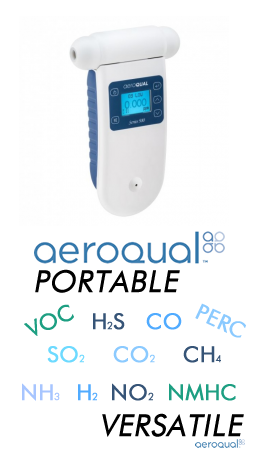Perchloroethylene

Perchloroethylene(PERC):
Perchloroethylene Safety and Detection information
Overview:
| Other Names: | PERC, PCE, perchlorethylene, tetrachloroethylene, tetrachlorethylene |
| Chemical Formula: | C 2 Cl 4 |
| CAS Number: | 127-18-4 |
| Industry Uses: | Dry Cleaning, Metal Degreasing, Chemical Manufacturing |
| Health Risks: | Carcinogen, Irritant, Adverse nervous system reactions |
| Vapor Pressure: | 14 mm Hg at 20o C |
| Water Solubility: | Insoluble |
| Flammable: | Non-Flammable |
| Odor: | Sweet Smell |
| Regulations: | EPA and OSHA |
| MSDS: | Perchloroethylene MSDS (.pdf) |
What is Perchloroethylene:
Perchloroethylene (PERC) is a clear, colorless liquid with a distinctive, sweet odor. Because it is most commonly used in the dry cleaning industry, it is often referred to as dry-cleaning solution. In addition to dry-cleaning, PERC is also used in the textile industry, metal degreasing, and in the production of other chemical products. It is not a flammable risk during storage or use, but it can pose a risk to users and the environment if proper precautions are not observed.
Health Risks:
Short term exposure to PERC can have affect nervous system, as well as irritate the skin, eyes, nose and throat. Symptoms include irritation, dizziness, fatigue, headaches and sweating - with loss of coordination and unconsciousness occurring in extreme cases.
Extended, ongoing exposure to PERC can cause liver and kidney damage, as well as memory loss and confusion. Studies have shown that it can also cause cancer in humans and animals.
Regulations:
EPA:
Perchloroethylene that escapes into ambient air can survive in the environment for many days - leading to easily measurable levels of PERC in the outdoor air of most major cities. For this reason, and due to the environmental impact that PERC can cause, the EPA has strict regulations on its use in industry - with specific attention paid to dry cleaners.
It is the responsibility of dry cleaners to measure the concentration of PERC in the dry cleaning machine's drum weekly - this is to be done at the end of a dry cleaning cycle with a PERC monitor and concentrations must be equal to or less than 300 ppm by volume. For this measurement, the sample tube of the monitor needs to be placed in the open airspace at the rear of the dry cleaning machine's drum, above the articles that were cleaned. This is to be done immediately when the cycle is complete and upon opening the door of the machine.
It is also the responsibility of the dry cleaner to inspect the machine weekly, while running, for any perceptible leaks of PERC into the air. For this inspection, the sample tube of the PERC monitor must be placed next to any joint (doors, lids, etc) where leaks may occur - then the sampling tube needs to be run along the entirety of that joint to ensure there is no leakage. Any leaks that are found must be fixed within the timeline laid out in the EPA regulations.
Link to the EPA's Perchloroethylene page here.
OSHA (and similar organizations):
Since employee health is also affected by exposure to Perchloroethylene, OSHA has set mandatory permissible exposure limits as laid out below.
| Worker exposure limits for Perchloroethylene (Tetrachloroethylene) | ||
|---|---|---|
| Organization |
8-hour time-weighted average (TWA) |
Other Limits |
|
OSHA (mandatory) |
Permissible Exposure Limit (PEL): 100 ppm |
Ceiling: 200 ppm (for 5 min in any 3-hr period), with a maximum peak of 300 ppm. |
|
ACGIH (voluntary) |
Threshold Limit Value (TLV): 25 ppm |
Short-term Exposure Limit (STEL): 100 ppm (15 min. TWA) |
| NIOSH |
Potential Occupational Carcinogen; Minimize workplace exposure |
|
Further information from OSHA can be found here: OSHA Perchloroethylene (PERC) in Dry Cleaning (.pdf)Tips for Monitoring
- In most cases, stationary sensor placement should be between waist and chest height (~4 ft)
- Don't rely on your nose for safety - olfactory fatigue can be deceiving.
- Check all possible leak points weekly (dry cleaners).
- Check response and calibration regularly (according to manufacturer's spec's) - keep a maintenance schedule for each device.
Downloads:
Tech specs on Aeroqual Perc Sensor
Perchloroethylene sensor with Series-200 monito
Perchloroethylene sensor with Series-300, 500 monitor
OSHA and Perchloroethylene regulationsEU
What type of component are you looking for?
| Fixed Mount | Handheld | Dissolved Kits: | Replacement Sensors: | Calibration Gas: | Rentals: |
 |
 |
 |
 |
 |
 |
All sensors require a yearly calibration to ensure your gas measurements are accurate and performing within manufacturer standards. This page is desiccated to the individual manufacturers we represent and their specific calibration procedures.
**Calibration Service Request Form **
|
Calibration costs do vary, see below to get an estimate: Calibration Fee: $150 Analyzer Calibration Fee: $300 PM Calibration Sensor Fee: $330 Genie Calibration Fee: $265 ATI Calibration Fee: $205 ** note that prices are subject to change per labor and parts required. |
Contact us for help choosing the right Perchloroethylene Sensor for your application

















